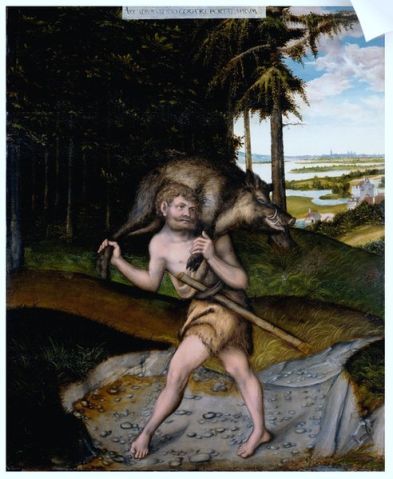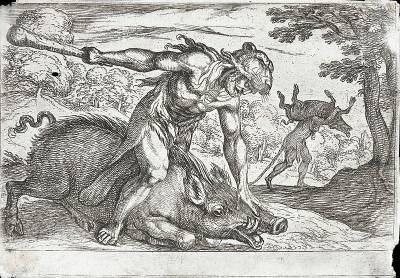The Erymanthian Boar was a big and dangerous creature living on Mount Erymanthos. Because of its untamed nature, this hefty beast would often raid the woods and destroy the farms near the city of Psophis. Heracles’ fourth labor was to capture the Erymanthian Boar and bring it alive to king Eurystheus.
Key Facts
| Parents | Unknown |
| Region | Arcadia |
| Siblings | Unknown |
| Offspring | None |
| Names | Erymanthian Boar |
| Ancient Greek | ὁ Ἐρυμάνθιος κάπρος |
Origins of the Erymanthian Boar

Although it is not known how it came to be, the Erymanthian Boar appeared one day on the outskirts of the city of Psophis, in northwestern Arcadia. The damage to the farm fields and the subsequent terror this beast brought on to the region was more than enough for the locals to bear. As his fourth labor, Heracles, The Strongest Hero succeeded in capturing the animal alive and carrying it to Mycenae.
Impact
The task of trapping the Erymanthian Boar and bringing it alive to king Eurystheus is surely one of Heracle’s great feats. The specific labor was a common theme for ancient Greek vase painters.
The myth of the Erymanthian Boar
The setting
The mount Erymanthos lies close to the northwestern edge of Arcadia, in Peloponnese. Once, an enormous beast came down its southeastern slopes; a wild boar. The citizens of Psophis, a peaceful city an arrow’s distance from Erymanthos’ foothills, were the first to be attacked by that creature. They fled within the city walls, but they did it with regret as they saw their crops and orchards being ruined. The ferocious animal that had rushed down from Erymanthos was called the Erymanthian Boar.
The beast
The Boar of Erymanthos was big, almost gigantic. It had a thick, brown hide that it was so tangled it created the impression of a hedgehog with tusks. But, this was not a hedgehog; this beast was a wild, untamed, uncontrolled and unstoppable boar. It roamed the glens and woods of the mountain, and surprised unwary travelers by charging at them. But, the Erymanthian Boar’s main occupation every day was to plunder the farms of Psophis. So, the residents of that region suffered a great deal under this ancient Greek monster. Each day they prayed to the gods for a hero to come and save them.
The hero
Before long, a hero came to their lands. His name was Heracles and he was the demigod son of Zeus, the king of the gods. Having already performed three labors, Heracles was sent to Mount Erymanthos to trap its notorious wild boar and bring it alive to king Eurystheus, in Mycenae.

Following the awful sound the boar made, Heracles located it near the edge of a small forest on the slopes of the mountain. The moment he saw it he started shouting to confuse and scare it. The trick had worked because the beast turned around quickly and fled with Heracles running close behind it.
But, the Erymanthian boar was fast and could not yield easily to the demigod man. It soon hid within a dense cluster of bushes. Heracles spotted it and thrusting his spear inside the thicket he managed to drive the beast out.
A new chase commenced, and Heracles pursued the boar higher up the mountain until they reached an area covered with deep snow. There, the boar’s speed and agility were no match for Heracles’ long legs. The hero neared the beast and trapped it in his net.
He then chained it and put its formidable weight on his shoulders. After this, Heracles carried the Erymanthian Boar all the way to Mycenae (approximately 100 km!) and completed thus his fourth labor.
King Eurystheus was more than convinced for this heroic deed as he got so afraid of the boar’s terrifying appearance that he hid inside a large clay vase.
Aftermath

As secretively as it came into the world the same way it went away. No account speaks of what really happened to the Erymanthian Boar after Heracles brought it to Mycenae. At best, only assumptions can relate to the end of that story. Some say that king Eurystheus ordered Heracles to put down the beast, and the hero complied. Others introduce the possibility that it was released in the wild where it was eventually devoured by wolves. Nothing is certain though, and the question about the true ending of the Erymanthian Boar remains a mystery.
In the old texts
Greek
Sophocles and Callimachus mention the Erymanthian Boar in their works.
‘…you checked the savage tribe of beasts, half horse,
half man, the lawless, mighty, violent Centaurs, The Half-Human, Half-Horse Beings,
subdued the Erymanthian Boar, and tamed
Hades, the god of the underworld‘ invincible three-headed Dog (Cerberus)…’
Sophocles’ Trachiniae
Apollonius Rhodius gives a detailed account of Heracles’ fourth labor about hunting and capturing the Erymanthian Boar.
‘Οὐδὲ μὲν οὐδὲ βίην κρατερόφρονος Ἡρακλῆος
πευθόμεθ’ Αἰσονίδαο λιλαιομένου ἀθερίξαι.
ἀλλ’ ἐπεὶ ἄιε βάξιν ἀγειρομένων ἡρώων,
νεῖον ἀπ’ Ἀρκαδίης Λυρκήιον Ἄργος ἀμείψας
τὴν ὁδόν, ᾗ ζωὸν φέρε κάπριον ὅς ῥ’ ἐνὶ βήσσῃς
φέρβετο Λαμπείης, Ἐρυμάνθιον ἂμ μέγα τῖφος,
τὸν μὲν ἐνὶ πρώτῃσι Μυκηναίων ἀγορῇσιν
δεσμοῖς ἰλλόμενον μεγάλων ἀπεθήκατο νώτων·
αὐτὸς δ’ ᾗ ἰότητι παρὲκ νόον Εὐρυσθῆος
ὡρμήθη·’
‘Nor do we learn that Heracles of the mighty heart
disregarded the eager summons of Aeson’s son.
But when he heard a report of the heroes’ gathering
and had reached Lyrceian Argos from Arcadia
by the road along which he carried the boar alive
that fed in the thickets of Lampeia, near the vast Erymanthian swamp,
the boar bound with chains he put down from his huge shoulders
at the entrance to the market-place of Mycenae;
and himself of his own will set out against the purpose of Eurystheus;’
Apollonius Rhodius’ Argonautica 1.122
Roman
The Erymanthian Boar is mentioned in Virgil’s Aeneid.
Lucretius, Ovid, Seneca and Nonnus talk about the Erymanthian Boar as well.
FAQs
Imagine a wild boar the size of a bear with tusks as sharp as knives rushing towards you. No doubt the sight would have been terrible for those who had witnessed it.
An ordinary boar can kill a grown human with its tusks. The Erymanthian Boar could kill a dozen and more, and also wreak havoc on the land. Therefore, it was really dangerous, as dangerous as an elephant into musth can be
Even though it was a beast of supernatural strength and size the Erymanthian Boar couldn’t talk. Not with a human voice at least because its growls and squeals must have been truly scary to hear.
Featured Image Credit: National Trust, Public domain, via Wikimedia Commons
